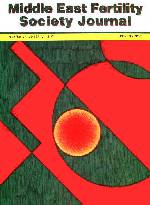
|
Middle East Fertility Society Journal
Middle East Fertility Society
ISSN: 1110-5690
Vol. 9, Num. 1, 2004, pp. 87-88
|
Middle East Fertility Society Journal, Vol. 9, No. 1, 2004, pp. 87-88
EVIDENCE-BASED
MEDICINE CORNER
Why
similar meta-analyses addressing the same topic reach different conclusions!
Hesham G. Al-Inany, M.D.
Code Number: mf04014
Data from IVF cycles
irrespective of the indication for IVF are not in concordance on which type of
gonadotrophin to be used. How to explain this conflict!!! According to EBM, we
should search for the best evidence in meta-analysis. The results of a
meta-analysis usually reflect a wide range of clinical settings and patient
characteristics; thus, the results can be broadly generalized among typical
patients. (Collins, 2003)
However,
results of meta-analyses can be very misleading if suitable attention has not
been given to formulating the review question; specifying inclusion criteria;
identifying, selecting and critically appraising studies; collecting
appropriate data; and deciding what would be meaningful to analyse.
Two
previous meta-analyses compared uFSH with hMG (Daya 1995; Agrawal 2000)
regarding clinical pregnancy rate. Daya 1995 showed favorable outcome for uFSH
over hMG. On the contrary, Pooling the trials included in Agrawal et al, 2000
that differentiated between different GnRHa protocols and found no significant
difference between urinary FSH and hMG. When used the long protocol, it
resulted in an odds ratio for clinical pregnancy rate per woman of 0,88 (95%
CI: 0.65-1.19). The meta-analysis of Daya did not differentiate between the
GnRHa protocols used.
Three
meta-analyses studying recombinant FSH reached different conclusions.
Recombinant FSH was found to yield higher pregnancy rates and the total
gonadotropin dose required was lower (Daya, 2002). In this meta-analysis Daya
concluded that for every 19 patients treated one additional patient would
conceive when treated with recombinant FSH. Spontaneous abortion, multiple
pregnancy, and OHSS rates were similar for both gonadotropins. However,
Al-Inany et al. found no evidence of increased clinical pregnancy rates when
recombinant FSH was compared with urinary FSH (Al-Inany et al., 2003). Another
recent meta analysis concluded that urinary HMG was associated with higher
clinical pregnancy rates in cycles down regulated by GnRH agonists (van Wely et
al. 2003).
Does this means that in
patients undergoing IVF firm conclusions cannot be reached regarding the choice
of gonadotrophin!!!!! Daya meta-analysis did not compare to hMG but compared
recombinant to purified and highly purified FSH (both have been withdrawn from
the market). Van Wely compared recombinant FSH to hMG included only five trials
(true and quasi-randomised RCTs) while Al-Inany et al meta-analysis has
included more truly RCTs with 2031 IVF/ICSI cycles and showed no statistically
significant difference between both drugs regarding live birth rate. Subgroup
analysis was done including only women down regulated with long protocol. There
was statistically significant difference in favor of hMG over recombinant FSH
O.R.: 1.27 (95% CI 1.00-1.62). The number needed to treat was calculated and
found to be 23. Thus, it would require 23 cycles of ART treatment to achieve a
single additional clinical pregnancy with hMG treatment compared with
recombinant FSH. A large treatment effect leads to a small NNT and vice versa. NNTs
for treatment should be small. It should be noted that NNT for Van Wely meta-analysis
was 18 while in ours is 23 (with more trials included). This figure could be
even increased with more trials.
In
conclusion, There is actually no conflict in conclusions reached by different
meta-analyses, but the difference between them come from the search date and
methodology design of each meta-analysis.
REFERENCES
- Daya S, Gunby J, Hughes EG, Collins
JA, Sagle MA Follicle-stimulating hormone versus human menopausal gonadotropin
for in vitro fertilization cycles: a meta-analysis. Fertil Steril. 1995
Aug;64(2):347-54
- Al-Inany H, Aboulghar M, Mansour R,
Serour G. Meta-analysis of recombinant versus urinary-derived FSH: an update.
Hum Reprod. 2003 Feb;18(2):305-13
- van Wely M, Westergaard LG, Bossuyt
PM, van der Veen F. Effectiveness of human menopausal gonadotropin versus
recombinant follicle-stimulating hormone for controlled ovarian
hyperstimulation in assisted reproductive cycles: a meta-analysis. Fertil
Steril. 2003 Nov;80(5):1086-93
- Collins J. A turbulent
arena. Fertil Steril. 2003 Nov;80(5):1117-2
Copyright © Middle East Fertility Society
|
